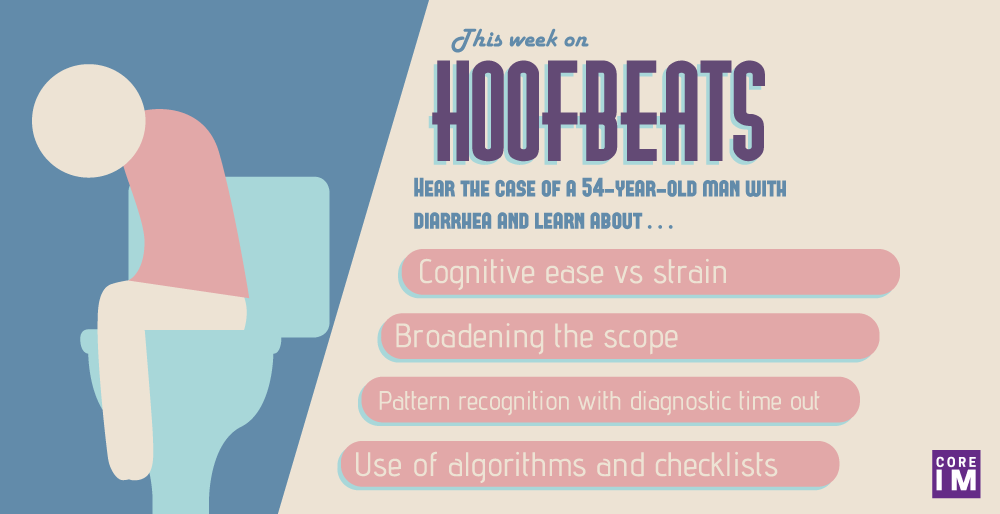Podcast: Play in new window | Download
Subscribe: RSS
 By Cindy Fang MD, John Hwang MD, Verity Shaye MD, Shreya P. Trivedi MD || Audio Editing by Richard Chen || Graphic by Amy Ou MD
By Cindy Fang MD, John Hwang MD, Verity Shaye MD, Shreya P. Trivedi MD || Audio Editing by Richard Chen || Graphic by Amy Ou MD
Time Stamps
- Part one of case (0:56)
- Cognitive ease and strain (03:51)
- Metacognition and routine diagnostic timeout (08:15)
- Think outside the box of organ systems (11:19)
- Illness behavior (12:30)
- Part two of case (14:06)
- Algorithms (17:57)
- Fast thinking & pattern recognition (19:30)
- Slow thinking & analytical reasoning (21:31)
- Diagnosis (25:15)
- Takeaways (26:52)
Subscribe to CORE IM on any podcast app! Follow us on Facebook @Core IM || Twitter @COREIMpodcast || Instagram @core.im.podcast. Please give any feedback at COREIMpodcast@gmail.com.
Show Notes
- “Cognitive ease” refers to the phenomenon when we face a common diagnosis or symptom, the impression of familiarity can create a false sense of ease, which make us more susceptible to diagnostic errors.
- It is important to think across systems: clinical reasoning should not be limited to organ-based approach as local symptoms can be signs of systemic illnesses.
- “Illness behavior” involves the psychosocial influences that affect how people monitor, define, interpret their symptoms as well as how they utilize health care resources.
- Pattern recognition is a powerful fast thinking tool that can be improved by practicing illness script and problem representation.
- Slow analytic thinking and metacognition are ways to balance the cognitive biases that frequently accompany fast thinking.
- Algorithms and tables can be great tools, but don’t let them dominate your clinical reasoning.
References
- Kahneman, D. Thinking, fast and slow. New York: Farrar, Straus and Giroux. 2011.
- Graber, M. Minimizing Diagnostic Error: 10 Things You Could Do Tomorrow. Lists for Physicians, Patients, and Health Care Organizations. 2014. Inside Medical Liability, PIAA, 2014. 22-26.
- Vick A, Estrada C, Rodriguez M. Clinical Reasoning for the Infectious Disease Specialist: A Primer to Recognize Cognitive Biases, Clinical Infectious Diseases, Volume 57, Issue 4, 15 August 2013, Pages 573–578,
- Barr, W. Smith, A. Acute Diarrhea in Adults. American Family Physician. 2014 Feb 1;89(3):180-9.
- Mechanic, D. The concept of illness behaviour: Culture, situation and personal predisposition. Psychological Medicine,1986; 16(1), 1-7.
- Reiseinger, EC., Fritzsche, C., Krause, R., & Krejs, GJ. Diarrhea Cause by Primarily Non-gastrointestinal Infections. Nat Clin Pract Gastroenterol Hepatol. 2005 May;2(5):216-22.
- Rawla, P., Bandaru, S. S., & Vellipuram, A. R. (2017). Review of Infectious Etiology of Acute Pancreatitis. Gastroenterology Research, 10(3), 153–158.
- Plotzker, R. Medical Trainees Must Move Beyond Algorithms, Medscape. Mar 28, 2018.
- Margolis CZ. Uses of Clinical Algorithms. JAMA. 1983;249(5):627–632.
- Khan FA, Fisher MA, & Khakoo RA. Association of hemochromatosis with infectious diseases: expanding spectrum. Int J Infect Dis. 2007 Nov;11(6):482-7. Available from DOI: 10.1016/j.ijid.2007.04.007

One comment on “Core IM Hoofbeats: 54M with diarrhea”
Hi Core IM Crew! Just wanted to say thank you for another awesome episode of Hoofbeats – I absolutely love this series! The cases are really interesting, but the careful examination of an expert clinician’s thought process is priceless. I was a medical student at NYU (Cindy, you were my intern at Tisch!), and it is so fun to hear such incredible teaching from a place I hold very dear. Thank you for all of your hard work, and for creating such an enjoyable teaching tool!
Julia Maheshwari (Roberts)
Comments are closed.